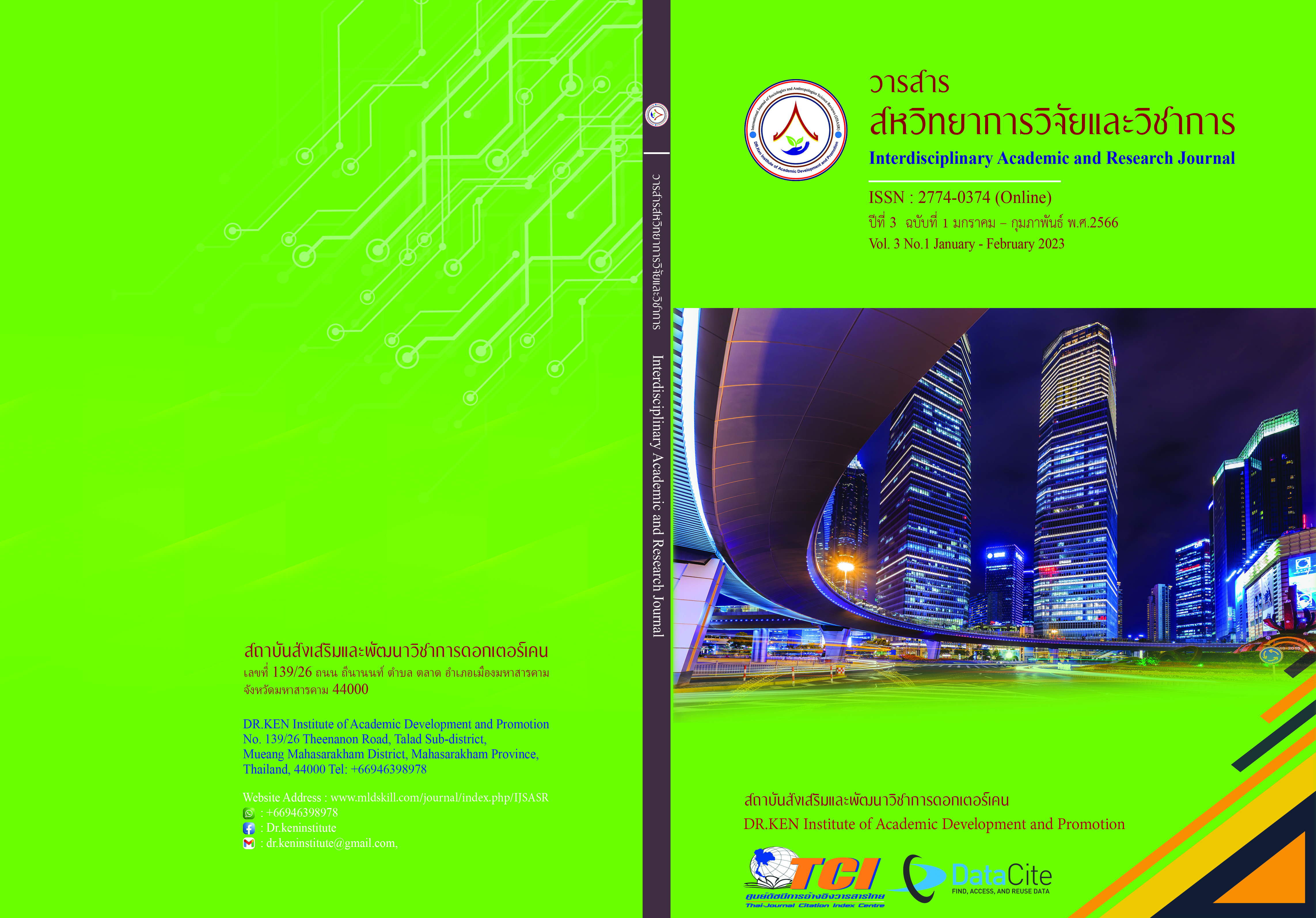A Construction of Information Literacy Skills Scale for Mathayomsuksa Three Students
DOI:
https://doi.org/10.14456/iarj.2023.37Keywords:
Construct of Scale; , Information Literacy Skills; , Construction of Scale Cut-scoresAbstract
The study of information literacy skills in the previous research has focused on the development of information literacy skills and the level of information literacy. The information literacy study lacked a measure of the information literacy skills of lower secondary school students and a cutting score used to determine the level of information literacy skills. The objectives of this research were 1) to construct an information literacy skills scale and 2) to set cut scores to consider information literacy skill levels. Samples were 1,020 Mathayomsuksa 3 students in the schools under Bangkok Secondary Educational Service Area Office Two by using a multi-stage random sampling technique. Data was collected by using an information literacy skills scale. And the test examined concurrent validity, reliability, item difficulty, and item discrimination to show test quality. Data were analyzed with descriptive statistics. The research results found that 1) the concurrent validity was 0.28, the reliability was 0.87, the item difficulty index between 0.25-0.87, and the item discrimination index between 0.19-0.47 and 2) the overall cut-score was 60%, with the students passing the cut-score of 34.00% while the cut-scores for each skill were as follows Information access skills, 70% cut-off point, 18.00 percent of students passed, information assessment skills, 60 percent cut-score, 44.00 percent of students passed, and information application skills, a cut-score of 60 percent. There is 47.00 percent of students passing the cut score.
References
ญาดา ศรีอรุณ. (2558). การศึกษาบทบาทครูสังคมศึกษาที่มีต่อการเสริมสร้างการรู้สารสนเทศของนักเรียนมัธยมศึกษา. วารสารอิเล็กทรอนิกส์ทางการศึกษา, 7(1), 147-160.
ณัฏฐภรณ์ เสารยะวิเศษ. (2562). รูปแบบการสอนการรู้สารสนเทศของนักศึกษาระดับปริญญาตรี มหาวิทยาลัยราชภัฏในประเทศไทย. วารสารจันทรเกษมสาร, 25(1), 128-124.
เดือนเพ็ญ หัสขันธ์. (2563). การรู้สารสนเทศของนักศึกษาระดับปริญญาตรีมหาวิทยาลัยราชภัฏในภาคตะวันออกเฉียงเหนือ. วารสารบัณฑิตศึกษา มหาวิทยาลัยราชภัฏสกลนคร, 17(76), 238-244.
นฤมล ศิระวงษ์. (2561). การศึกษาทักษะความฉลาดรู้สารสนเทศสำหรับนิสิตครู มหาวิทยาลัยศรีนครินทรวิโรฒ. วารสารวิชาการมหาวิทยาลัยธนบุรี, 12(29), 96-105.
ปาริชาต เสารยะวิเศษ. (2552). การพัฒนาการรู้สารสนเทศของนักศึกษาระดับประถมศึกษาในประเทศไทย. วิทยานิพนธ์ปรัชญาดุษฎีบัณฑิต: มหาวิทยาลัยขอนแก่น.
พิชิต ฤทธิ์จรูญ (2560). หลักการวัดและประเมินผลการศึกษา. พิมพ์ครั้งที่ 11. กรุงเทพมหานคร: เฮ้าส์ ออฟ เคอร์มิสท์.
ลัดดาวัลย์ อู่แสงทอง. (2562). การประเมินทักษะความฉลาดรู้สารสนเทศของนักศึกษาระดับปริญญาตรีสถาบันบัณฑิตพัฒนศิลป์. วารสารวิจัยสมาคมห้องสมุดแห่งประเทศไทย, 12(1), 13-25.
วลัยลักษณ์ อมรสิริพงศ์. (2561). การรู้สารสนเทศของนักศึกษาปริญญาตรี มหาวิทยาลัยราชภัฏนครปฐม. วารสารสารสนเทศศาสตร์, 36(3), 40-63.
วัลลภา เฉลิมวงศาเวช. (2560). การวิเคราะห์องค์ประกอบเชิงยืนยันของการรู้สารสนเทศของนักศึกษาในมหาวิทยาลัยเอกชน. วารสารคณะศึกษาศาสตร์ มหาวิทยาลัยรังสิต, 16(2), 59-68.
ศิริชัย กาญจนวาสี. (2556). ทฤษฎีการทดสอบแบบดั้งเดิม. พิมพ์ครั้งที่ 7. กรุงเทพมหานคร: โรงพิมพ์แห่งจุฬาลงกรณ์มหาวิทยาลัย.
สมฤดี หัตถาพงษ์. (2547). การรู้สารสนเทศของนิสิตระดับบัณฑิตศึกษา. วิทยานิพนธ์ศิลปศาสตรมหาบัณฑิต สาขาวิชาบรรณารักษศาสตร์และสารนิเทศศาสตร์ บัณฑิตวิทยาลัย มหาวิทยาลัยศรีนครินทรวิโรฒ.
อนันศักดิ์ พวงอก. (2560). การพัฒนาทักษะการรู้สารสนเทศของนักศึกษาระดับปริญญาตรี มหาวิทยาลัยราชภัฏศรีสะเกษ. วารสารวิชาการมนุษย์และสังคมมหาวิทยาลัยราชภัฏศรีสะเกษ, 2(1), 7-22.
อาชัญญา รัตนอุบล. (2550). การพัฒนารูปแบบการเสริมสร้างการรู้สารสนเทศสำหรับสังคมไทย. กรุงเทพฯ: คณะครุศาสตร์ จุฬาลงกรณ์มหาวิทยาลัย.
Angela, S. (2020). Historical development of definitions of information literacy: A literature review of selected resources. The Journal of Academic Librarianship, 46(2), 1-8.
Cheyvuth, S., May, K. J. & Jeffrey, S. C. (2020). Information literacy training effectiveness on Cambodia’s province-based undergraduates. Information literacy training effectiveness, 22(4), 263-280.
Danica, D., Bojana, B. P., Tomaz, B. & Andrej, S. (2020). Added value of secondary school education toward development of information literacy of adolescents. Library and Information Science Research, 42(2), 1-18.
Farhan, A., Gunilla, W., & Isto, H. (2020). The impact of workplace information literacy on organizational innovation: An empirical study. International Journal of Information Management, 51,1-12.
Manoj, K. V., & Ravi, S. (2021). Information Literacy Skills among the Masters’ Students of Social Sciences Departments of Mizoram University and Tezpur University: A Comparative Study. Journal of Library & Information Technology, 41(5), 374-384.
Musediq, T. B., Rafiat, B. B., & Aishat, T. A. (2021). Evaluating Information Literacy competence in the Use of Electronic Resources among Medical Students in University of Ilorin, Nigeria. University of Dar es Salaam Library Journal, 16(1), 131-148.
Reem, A. Z., (2021). The impact of media and information literacy on acquiring the critical thinking skill by the educational faculty’s students. Thinking Skills and Creativity, 39,1-7.
Stephanie, J. G., Sarah, L., & Kathy, C. A. (2021). Uncovering the information literacy skills of first-generation and provisionally admitted students. The Journal of Academic Librarianship, 47(1), 1-10.
Downloads
Published
How to Cite
Issue
Section
License
Copyright (c) 2023 Prawva Sanamnoi, Kamontip Srihaset, Darunee Tippayakulpairoj

This work is licensed under a Creative Commons Attribution-NonCommercial-NoDerivatives 4.0 International License.
Copyright on any article in the Interdisciplinary Academic and Research Journal is retained by the author(s) under the under the Creative Commons Attribution-NonCommercial-NoDerivatives 4.0 International License. Permission to use text, content, images, etc. of publication. Any user to read, download, copy, distribute, print, search, or link to the full texts of articles, crawl them for indexing, pass them as data to software, or use them for any other lawful purpose. But do not use it for commercial use or with the intent to benefit any business.
















.png)


